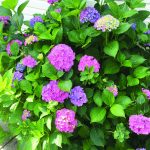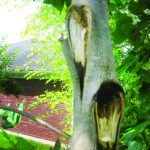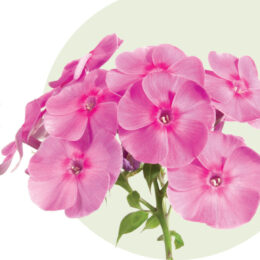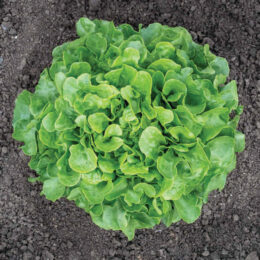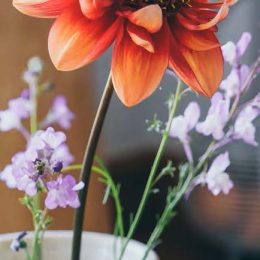‘Endless Summer’ never even arrived
I know you’ve addressed the ever-frustrating and puzzling hydrangeas that refuse to bloom, but I’m reaching out as a final attempt to solve the mystery of my disappointing non-bloomers. I’ve done everything I can think of, including fertilizing, researching optimum soil and light conditions, careful pruning of only old blooms late in the spring, covering them with towels to protect them from late frosts and waiting patiently – OK, maybe not so patiently — but waiting nonetheless for seven years!
hey were supposed to bloom on new and old wood throughout the summer months. They were called Endless Summer. I planted about 12 of them. Three are planted on the north side of my house against the garage wall. These three are the only ones that ever bloom. (These are the ones in the photo.) All the others I planted on the south side of my house. They aren’t up against the house like the others. They get morning sun and some afternoon sun, but some shade in midday. Overall, the plants are green and healthy-looking but never bloom. What do I need to do? What might be the problem? I appreciate any insight or advice you may have to offer! Thank so much for your help!
— Shannon Dean, Bloomfield, Indiana
Sadly, many Indiana gardeners find “Endless Summer” failing to deliver summerlong blooms, myself included. In most areas of the state, they will die back to the ground but should be able to bloom on the new growth by mid- to late summer. Mine has never performed well over 10 years, at most one or two bloom clusters per year. I have mine planted in morning sun, afternoon dappled shade, and though it dies back to the ground each year the new growth is healthy, green and robust. This year I’ve had one flower cluster thus far. It could be that our hot summers are just too much for them, often wilting during hot afternoons even if the soil is moist.
Some Indiana gardeners do have good luck with their Endless Summer hydrangeas, but I have not been able to determine that they do anything different from those of us that have less success. Some advocate covering the plants with mulch for winter; others have had good results with applications of blooming plant fertilizer. In late winter or early spring, you can cut the dead stems back to live buds or to the ground and let the new twigs emerge from lower on the base of the plant.
In your case, it seems that the three you have planted on the north side of the wall are performing quite well – I envy your success! Endless Summer was the first selection of H. macrophylla that blooms on new wood. There are some newer selections of re-blooming H. macrophylla on the market, including Let’s Dance, Forever and Ever and Twist-n-Shout. Perhaps it is time to try one of those?
Large wounds not likely to heal
I’ve attached a photo of one of my trees. I’m concerned that the tree will not heal, and if it does will be too weakened.
— Gerald Fox, Jeffersonville, Indiana
Looks like perhaps this was storm-related damage? Tulip trees are somewhat weak-wooded and can be susceptible to limb breakage during strong storms. While it is difficult to assess from just the photos, I don’t think there is much you can do for the wounds that are already there. Wound dressing and tree paint are NOT recommended; they don’t help, and they can interfere with the tree’s natural wound closure process. These wounds are large enough that the tree might never be able to fully close that tissue and so those areas do remain a susceptible point for further decay and disease. Trees can survive for many years with such damage, but you may want to consult a certified arborist to determine if the tree poses a hazard.
Purdue Forestry and Natural Resources Department has an excellent publication on hiring a professional arborist at https://www.extension.purdue.edu/extmedia/fnr/fnr-faq-13-w.pdf.
You can search for a certified arborist in your area by visiting
http://www.isa-arbor.com/findanarborist/findanarborist.aspx.
Questions abound for fruit trees
I have two peach saplings and three apple saplings that I would like to plant within 15 feet of each other. Is there a specific arrangement I should plant the trees in? I was planning on a 15-foot square with an apple tree at two corners and the peach trees on the opposing corners. The third apple tree would be offset 15 feet from the square arrangement. Also, do apple trees need a different type of apple pollen to propagate?
— Robert Richter, Borden, Indiana
Are these saplings ones that you purchased as dwarf trees, or are they ones that you’ve grown from seed? Your proposed spacing could be too crowded for all but the most dwarf apple trees and will likely be too close for peach. Count on the trees maturing as wide as they are tall. Good air circulation and light penetration is critical for disease prevention, and you’ll need space to access for maintenance, harvest, etc.
If your saplings are dwarf trees, spacing at 20-25 feet apart would provide sufficient space yet be close enough to facilitate cross pollination. If these are seedling trees where mature height and fruiting quality will not be predictable, you’ll need considerably more space. And cross-pollination needs of seedling trees are not predictable.
Cross-pollination requirements vary by cultivar and species of fruit tree. Most cultivars of apple do need to be pollinized by a different but compatible cultivar in order to set fruit, though there are a few that are considered self-fruitful. Peaches do not require cross pollination.
Rosie Lerner is the Purdue Extension consumer horticulturist and a consumer of Tipmont REMC. Have a question about gardening? Use the form to send it to us. Or, questions about gardening issues may be sent to: “Ask Rosie,” Electric Consumer, P.O. Box 24517, Indianapolis, IN 46224, or ec@ElectricConsumer.org.

